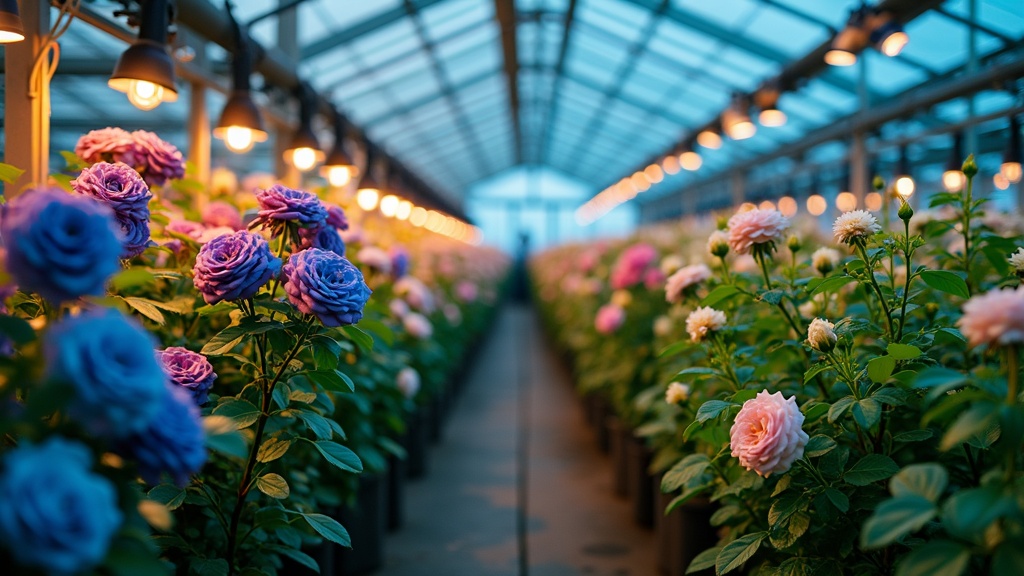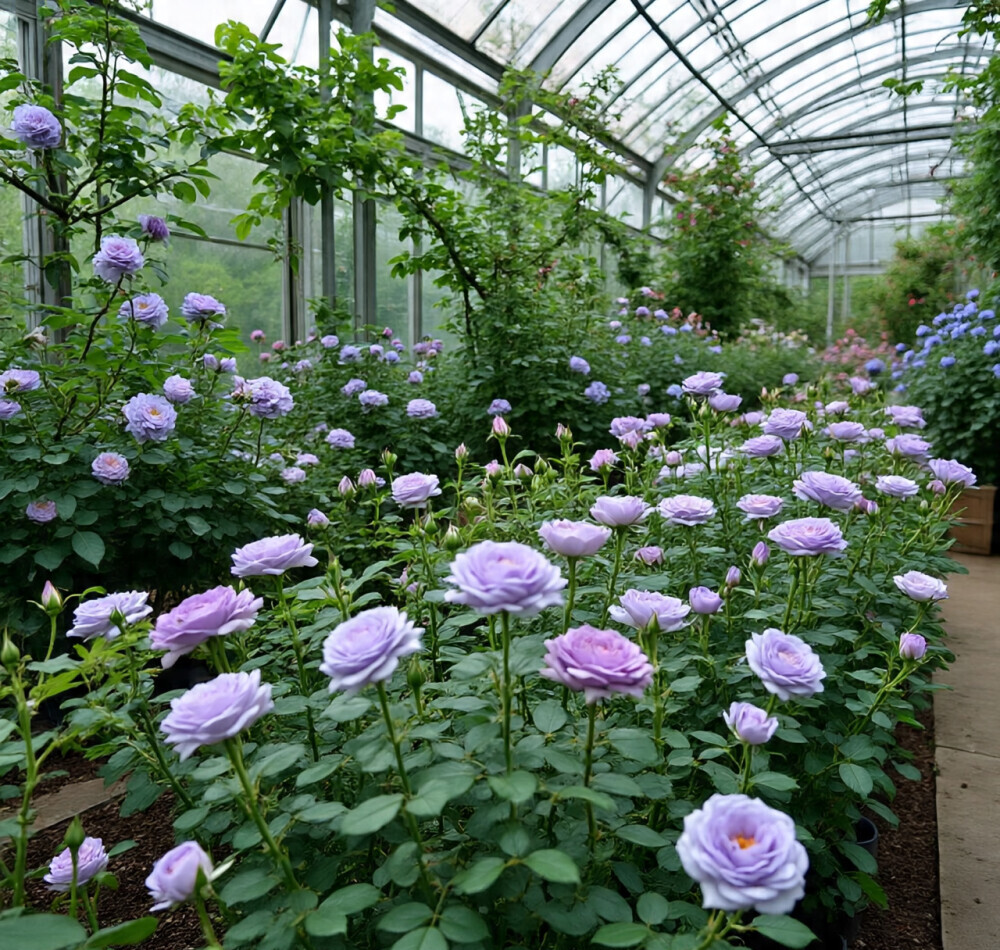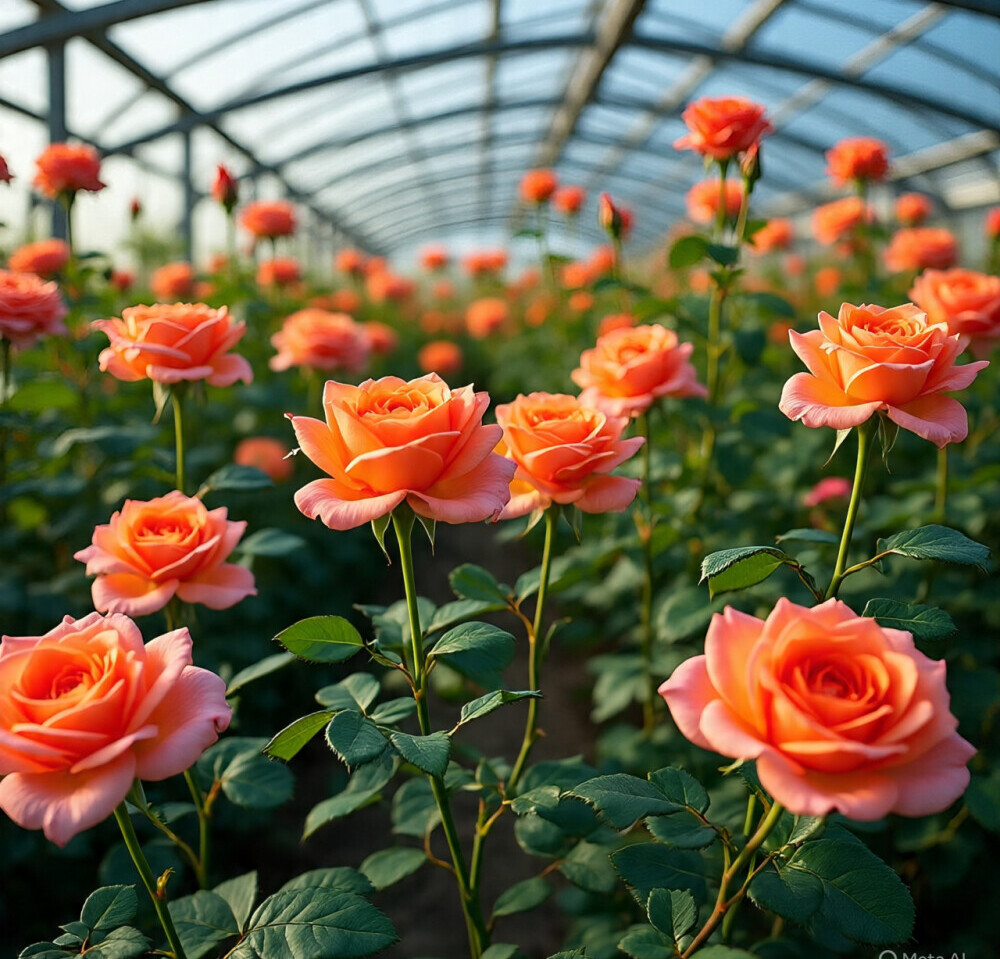Roses with colors like blue, jet black, deep purple, bright green, or even classic striped patterns almost seem too wild to exist in nature.
Yet, walk through a well-managed greenhouse and you’ll spot some of these rare shades, often more vivid than anything seen outdoors.
Controlled environments let growers tweak the exact conditions that influence how pigments in rose petals are produced. This approach unlocks new levels of color that just don’t show up in a backyard garden.

The Science Behind Rose Pigmentation
Roses get their color from natural pigments.
The main players are anthocyanins, which make reds, blues, and purples, and carotenoids, responsible for yellows and oranges.
There are also flavonols that can add a subtle white or creamy tone. The specific way these chemicals combine, along with the pH in the petal’s cells, determines the shade you see on each bloom.
Some colors, like true blue or pure black, are basically out of reach for most wild roses.
That isn’t due to a lack of effort from breeders; it’s because roses don’t have the right genes to make certain pigments in large amounts.
For example, anthocyanins can get close to blue, but the petal’s internal chemistry usually makes the shade lean more toward purple or magenta.
The environment adds another layer of complexity. If the plant doesn’t get enough light, the color can look faded.
If the temperature is off, or the soil is missing key nutrients, the petals might not form pigments properly.
Sometimes a streak or odd color is the result of a mild stress on the plant, which isn’t necessarily bad, but it suggests that conditions could be adjusted for a better result.
Greenhouse Conditions That Change Rose Colors
Greenhouses make it possible to adjust nearly every factor that matters for rose color:
- Light Intensity and Spectrum: Roses love light, but the precise mix of light wavelengths can nudge petal color in different ways. Extra blue light usually creates richer blues and purples, while more red light can deepen red shades.
- Temperature: Cool nights and moderate days bring out deeper reds and purples. Very hot days can lead to washed-out or pale colors, especially in pastel shades.
- Humidity: Maintaining steady humidity keeps petals from drying out, which helps flowers open up with the full color. Too much humidity, on the other hand, can lead to mildew or less crisp blooms.
- Soil Composition & pH: The minerals and acidity in the soil have a big impact on pigment production. For example, slightly acidic soil can intensify blue and purple hues in some varieties.
Greenhouse Techniques for Boosting Unusual Colors
Growers make use of a variety of tricks and technologies to bring out eye-catching hues that just don’t show up outdoors. Some of the most effective approaches include:
- Shading Nets & Grow Lights: Mesh screens or fabric filter out harsh sunlight at midday, stopping colors from bleaching out. Grow lights allow you to experiment with different wavelengths to see which shades come out best.
- Temperature Control: Fans, heaters, or simple shade cloths help avoid extreme temperature swings, giving pigment development a boost. This is especially important for deep reds, purples, and blacks.
- Irrigation and Fertigation: Nailing down moisture levels and nutrient balance helps roots take in what they need to show off classic blues, greens, or lavenders. Hydroponic setups can actually deliver more uniform results than soil in some greenhouses.
- CO₂ Enrichment: Adding extra CO₂ speeds up plant growth overall, which often means fuller, stronger blooms and, in many cases, even brighter petal color.
Case Examples: Greenhouse Magic for Specific Unusual Colors
- Blue Roses: True blue roses haven’t yet popped up naturally. Usually, what you see are either white roses that have been dyed or genetically engineered types with improved pigment. Inside, lighting and careful pH balance help keep blue-tinted flowers bright and avoid a muddy look.
- Black Roses: The legendary “black” rose is actually a rich maroon or deep burgundy. Cooler greenhouse temperatures help bring out these almost-black shades, with petals that open up looking velvety and dark. If the temperature is too high, this dramatic look usually fades.
- Green Roses: So-called green roses are usually hybrids or cultivars where the sepals are noticeably leafier and often contain some green pigment. Steady temperature and humidity let this unique color develop cleanly, without brown patches or fading edges.
- Purple and Lavender Roses: These shades come from a particular mix of anthocyanins and precise pH levels. Bringing in bright, natural light with a little bit of shade during the hottest hours helps create really bold purple tones.
- Striped Roses: Most rose stripes result from a mix of genetics and a bit of environmental stress, such as a cool night. Growers in greenhouses can encourage clear stripes by avoiding sudden changes in key conditions.
Why Grow Rare Rose Colors in Greenhouses?
There are plenty of good reasons to raise rare or unusual roses indoors:
- Complete control over the flowers’ color—no more losing a whole season’s blooms to surprise weather changes.
- Better protection from pests or diseases that could leave marks on petals and spoil color purity.
- The ability to extend the blooming season, especially helpful for selling cut flowers, decorating weddings, or participating in contests where unique colors are highly prized.
- Unusual roses typically command higher prices at market. Consistently producing rare shades can make floral businesses stand out.
Common Problems with Greenhouse Rose Pigmentation
Growing rare roses indoors isn’t without its challenges. Common issues include:
- Temperatures that soar too high—leading to dull colors, wilting petals, and even buds dropping before they open.
- Humidity getting out of control—flowers may bloom, but then develop fungus spots or brown edges in a hurry.
- Significant startup costs—getting good lighting, temperature control, and irrigation systems up and running comes with a real price tag.
Handy Tips for Getting the Best Rose Pigment
- Pick a soil mixture with balanced organic matter, solid drainage, and a slightly acidic pH between 6.0 and 6.5 for stronger reds and purples.
- Use slow-release, bloom-friendly fertilizers loaded with magnesium and trace minerals—these really help pigment production.
- Regularly check both your soil’s pH and moisture with simple digital meters. Staying on top of these factors can help you avoid bigger issues down the line.
- Prune plants for better airflow—good circulation wards off fungus and keeps blooms pristine.
- Take time each day to look over your greenhouse, watching for pests, faded colors, or patchy growth. Tweak conditions as soon as you catch something odd.
Recommended Products for Growing Rare Rose Colors
- Greenhouse Kits or Polycarbonate Tunnels: Perfect for keeping temperature and humidity in check all year.
- Shade Nets and Full Spectrum Grow Lights: Must-haves if your area gets intense sun, or if you want complete control over your lighting.
- Soil pH and Moisture Meters: Essential for monitoring the little details that drive color changes in your roses.
- Bloom-Boosting Fertilizers: Go for fertilizers with extra magnesium or key trace minerals—they deliver the richest petal colors.
FAQs About Greenhouse Rose Colors
Do greenhouse roses show stronger colors than ones grown outside?
Most of the time, yes—especially when it comes to blues, purples, and rich reds. A steady, controlled environment helps color stand out and prevents fading.
Can I grow black or blue roses in a greenhouse?
Black roses are really intense reds or purples, and keeping greenhouse temps cool and steady makes sure they bloom at their boldest. For blue roses, genetically engineered or dyed options look their best under greenhouse conditions.
What’s the ideal temperature range for rare rose colors?
Daytime temperatures between 18–25°C (64–77°F) and cooler nights do the trick for deeper, more vivid hues. Avoid letting the heat spike, since even hardy flowers can lose their color in a heatwave.
Do greenhouse roses keep their color once they’re cut?
They often hold up better, since petals aren’t exposed to sun, wind, or bugs before harvest. Even then, treating your cut roses with care matters a lot for lasting color.
Wrapping Up
Greenhouse growing really is a game changer for those wanting rare or super vivid rose colors.
By adjusting light, temperature, water, and soil, you can get shades that are tough or almost impossible to achieve outside.
Interested in what these rare rose hues symbolize?
Check out the next part of this series: Symbolism of Rare Rose Colors – What Blue, Black, and Lavender Roses Really Mean.
Happy gardening and stay tuned!!!!!!!!!
Here’s a little transparency: Our website contains Amazon affiliate links. This means if you click and make a purchase, we may receive a small commission. Don’t worry, there’s no extra cost to you. It’s a simple way you can support our mission to bring you quality content.”




As a hobby rose grower, I’ve noticed that blooms from my small greenhouse have a different depth of color compared to those in my outdoor beds. The controlled temperature swings seem to intensify pigments; for example, cooler nights often give my reds a richer, velvety tone. I’ve also experimented with shading cloth and LED grow lights, which can coax out unusual purples and smoky hues that you rarely see outside. Have you found that playing with the light spectrum or photoperiod can nudge certain varieties toward these unique colors without resorting to dyes? I’m also curious whether the roses grown under glass hold their color as well when cut and brought indoors compared to those grown in the full sun. It’s fascinating how tweaking environmental variables can draw out hidden potential in familiar varieties.
Thank you, A Jaynes, for sharing your experience with growing roses in a greenhouse.
I’ve found that controlled environments can indeed intensify pigments and create unique color effects. Playing with light spectrum and photoperiod can definitely influence rose colors, and some growers have success with using LED grow lights to enhance specific hues.
As for color retention when cut and brought indoors, it varies depending on the variety and growing conditions.
Generally, roses grown under glass tend to hold their color well, but they may not last as long as those grown in full sun.
Your experimentation with shading cloth and LED grow lights is fascinating – it’s amazing how tweaking environmental variables can reveal hidden potential in familiar varieties.
Have you noticed any differences in fragrance or petal texture between your greenhouse and outdoor-grown roses?”